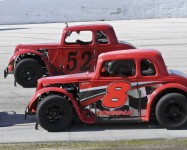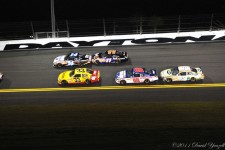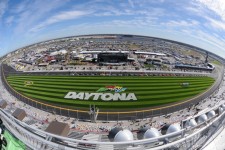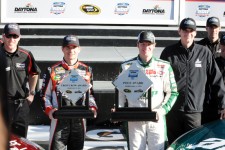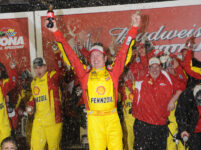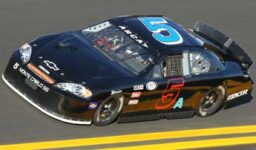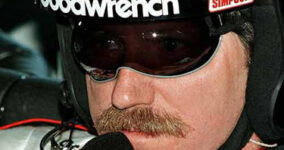[media-credit name=”David Yeazell” align=”alignright” width=”246″]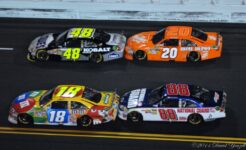 [/media-credit]The NASCAR Sprint Cup Series officially kicked off their 2011 season with the 33d annual invitational race known as the Budweiser Shootout. The 75 lap event brought some radically new changes to restrictor plate racing at Daytona. We also got introduced to some new racing terms such as “two car lockups”, “team mate for a day” and even “dancing with the stars.” With those thoughts in mind let’s begin this week with:
[/media-credit]The NASCAR Sprint Cup Series officially kicked off their 2011 season with the 33d annual invitational race known as the Budweiser Shootout. The 75 lap event brought some radically new changes to restrictor plate racing at Daytona. We also got introduced to some new racing terms such as “two car lockups”, “team mate for a day” and even “dancing with the stars.” With those thoughts in mind let’s begin this week with:
HOORAH to Kurt Busch for winning the Budweiser Shootout following a stunning finish that saw the race conclusion unveil itself during the final few feet to the checkers. The Las Vegas driver led three of the race’s 75 laps for his first ever Budweiser Shootout win, and a paycheck worth $203,000, in his Roger Penske Racing Dodge. The event was also the first Shootout win for Dodge.
One of the more interesting aspects of this event was the multiple use of the two car drafting technique instead of the long draft lines we’ve seen in the past at Daytona. This was often referred to as “two car lockups.” It was a game of drivers finding out who they could line up and bump draft the best with. It was also a little hairy at times because the second driver had trouble seeing the track in front of the first car. That led to the driver’s spotters working together in order to quickly convey on track information.
It was Jaime McMurray’s Chevrolet that actually pushed Busch into the lead during the final few feet of the race. In victory lane a very appreciative Busch called him his “team mate of the day.” That’s a term you’re likely going to hear a lot during the course of Thursday’s Gatorade Duel qualifying events as well as Sunday’s Daytona 500.
Busch deserves another HOORAH for coining that new racing term as well as a second one when he said “someone call Helio Castro Neves because this is “Dancing With The Stars.” He was of course referring to the IZOD Indy Car champion who surprised us all when he appeared on the popular ABC television show and then danced his way to the winner’s trophy.
But it was the conclusion of the Budweiser Shootout that everyone is still talking about. On that final quarter lap Ryan Newman was the race leader with Denny Hamlin right on his bumper. Newman’s Chevrolet inched up just a bit in the tri-oval and that’s when Hamlin dropped to the extreme bottom of the track to attempt a winning pass. Unfortunately Hamlin’s tires went below the two yellow safety lines which is an automatic disqualification. NASCAR officials dropped Hamlin from first to 12th in the final finishing order.
One would think that a mistake like that would automatically generate a WAZZUP. But I’m going to make an exception here and give Hamlin a HOORAH for his mature attitude and the decision he felt he had to make when his car drifted below the yellow lines. After the race Hamlin said he had no problem with NASCAR’s decision and added “the yellow lines are there to protect us and for the fans in the stand’s safety. I just chose to take the route. Winning a Shootout is not worth sending Newman through the grandstands. And for me, as fast as we were running, if I got into his left rear that car would have went airborne.”
***********************
Having said that, Hamlin absolutely gets a WAZZUP regarding that bizarre incident that occurred with his steering wheel during Sunday’s qualifying session for the Daytona 500. Due to space restraints, the steering wheels of Sprint Cup race cars are removed so a driver can get in and out. When Hamlin crawled into his Joe Gibbs Racing Toyota, he attached the steering wheel onto the column but apparently didn’t give it a tug to insure that it was properly secured.
After exiting pit road Hamlin pulled out onto the track only to have the car make a sharp left turn all by itself. That’s because the steering wheel came off in the driver’s hands. Fortunately he was only doing approximately 70 MPH at the time, but the car veered into the infield grass and there was some minor damage to the front end. Hamlin did an obligatory slow lap to officially qualify for the race and then brought the car back to the garage for repairs.
*************
HOORAH to the Junior Nation, the official fan club of Dale Earnhardt Jr, who have found their smiles again. Okay, I’m well aware that Earnhardt crashed out of Saturday night’s Budweiser Shootout after being caught up in a WAZZUP moment triggered by drivers Regan Smith and Carl Edwards. But prior to that, the car and the driver looked really strong.
His primary car for the Daytona 500 looked even stronger after Earnhardt locked up the pole position for the 500 following Sunday’s qualifying. He accomplished that by turning in a lap of 186.089 MPH. His team mate, Jeff Gordon, posted the second fastest speed marking the third time a Daytona 500 will start with a front row from Hendrick Motorsports.
Meanwhile the girl friend, still a T shirt wearing card carrying member of the Junior Nation, spent Sunday evening strutting her stuff, in her Junior Nation official clothing, while grinning like the proverbial cat who ate the canary. I, on the other hand, had to sit there and take it because I’m old enough and smart enough to know not to make wise cracks the day before Valentines.
**************
HOORAH to young rookie driver Trevor Bayne who guaranteed himself a start in the 500 by qualifying his Wood Brothers Ford third on the speed chart. After the run, the happy young driver said “I didn’t know I could hold my breath for a minute and a half.”
But the Wood Brothers had a back up plan to make the Daytona 500 via the NASCAR Stock Exchange. In other words they made a deal to acquire owner’s points which would place them in the top 35 of the owner’s points standings. As we all know, any team within the top 35 is guaranteed a start in Sunday’s race. It also guarantees them a WAZZUP from yours truly.
This arrangement was made with Richard Petty Motorsports who had 2010 owner’s point available from their now defunct #19 team. The details called for the creation of a new racing organization that was named Wood Brothers 2 LLC with Richard Petty being named as the official owner of record of the #21 Ford Fusion. This move, approved by NASCAR, is being referred to as an equity partnership.
Seriously? Equity partnership? I call it buying your way into the Daytona 500.
*************
The final WAZZUP of the week involves a bizarre incident from a jet dryer belonging to the Daytona Speedway. Following a crash, suffered by driver Jamie McMurray during Friday’s practice session, the speedway clean up crew came out onto the track. All of a sudden the engine of this very expensive jet powered dryer burst into flames. It was a sight we may never see again.
We have two final HOORAHS for you. The first goes to SPEED Channel analyst Kyle Petty who was participating in a lively panel discussion regarding NASCAR’s very popular have at it boys, police yourselves, policy initiated last year. During the course of the topic there was a video overlay of last year’s alleged fight between drivers Jeff Burton and Jeff Gordon. I refer to that moment as alleged because I still say I’ve seen girls in cocktail lounges fight better than that.
Apparently Kyle Petty has a similar opinion because he said “I’m still not sure if that fight was Ali versus Frazier or Laverne and Shirley. That’s just one more reason why everyone loves Kyle Petty.
The final HOORAH of the week goes to Fox Sports for their very limited appearances from their animated mascot “Digger.” I honestly can’t tell you exactly why that cartoon fat rat bothers me. Perhaps I should seek professional help and deal with this issue once and for all. Then again, I could spend the money on Budweiser at which point, following a certain point in time and libation, “Digger” simply won’t matter anymore.


